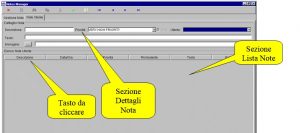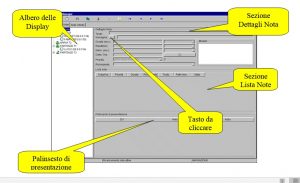OPERATIONS
NOTES MANAGER
OVERVIEW
In a crowded environment such as an airport, it is vital to arrange an automatic tool addressing, immediately and everywhere, information to passengers, to answer both to safety and to general information needs.
Notes Manager is the system aimed at distributing general-purpose messages using airport Display Units.
In this context is defined “note” a message of general interest such as courtesy messages, welcome messages, safety message, etc.
Notes Manager has been designed with a user graphical interface capable of producing notes defining the text associated, the Display Units where to present them and the presentation period.
In order to prepare a note correctly, a user has to configure a set of attributes to define the presentation contents and criteria exactly.
Defining a note means: create a text, associate an optional image, establish the period of permanence on the Display Units and presentation intervals, define the priority.
The user can also prepare an archive of general notes to be used in order to accelerate the process.
The priority level of a note defines the severity level compared with other current notes. In this way, the user can define the order the notes will be shown on the screen depending on the importance of the message to be presented.
Therefore, Notes Manager not only allows the configuration of the notes, but it presents them on the Display Units located in the airport.
Users can connect a note to each individual Display Unit or to well-identified groups. Moreover, users can display the note in a specific location of the airport area. In this case, the note will be displayed on each Display Unit placed in that location. So, if the user associates the note to the Arrival Area, it will be displayed on each DU of that area.
BENEFITS
A huge advantage of the Notes Manager is the ability to define
“presentation formats of the notes appearing on the DUs according to the different needs and to the specific positioning of the displays on the airport site A style is defined by a set of elements depending on the type of presentation that is desired”.
“different and multiple elements that make up the visualization structure of Notes, it is possible to customize the graphic configurations in a very detailed way and present the information to the public with precision and accuracy”.
SOLUTION COMPONENTS
DISPLAY UNIT
Each DU is composed of several Layers, ie multiple sheets that can contain data from different sources.
Each Layer consists of multiple Layer View, in other words multiple windows within a layer. A data source is associated with each LayerView. Data sources, synthetically named DataSource, are nothing more than the various systems belonging to the AOSNice framework able to generate data to be presented on Display Units (FIND, Advertising, Notes Manager, etc.).
Each LayerView consists of one or more Data View that presents data based on the styles associated with the latter.

Display Units are the most common means of presenting, to staff and passengers, information related to the notes managed by the airport itself.
The philosophy of configuration and management of the Notes Manager, on the basis of which DUs can be used simultaneously by various airport systems, opens new frontiers on the potential of airport information. As an example, we can imagine that both on the same DU can be shown both welcome messages and advertising messages through simple configuration operations.
CONFIGURATION OF STYLES
A huge advantage of the Notes Manager is the ability to define presentation formats for the notes that appear on the DUs according to the different needs and to the specific placement of the displays on the airport site. The Notes Manager system administrator can configure a style for each type of presentation to assign to the Display Units.
A style is defined by a set of elements depending on the type of presentation that you want to achieve. The richness of the configuration elements of the styles allows an effective and pleasant definition for all presentation needs.
Therefore, visualization standards are created that the System Administrator can always modify according to the needs of the airport.
By combining the different and different elements that make up the visualization structure of Notes, it is possible to customize the graphic configurations in a very detailed way and present the information to the public with precision and accuracy.
Each style consists of one or more logical lines.
Each logical line consists of a certain number of columns. Multiple columns can be aggregated into a single container, called a group, characterized by specific geometric and graphic characteristics. Groups can also be defined as empty containers that can only be used for graphic purposes.
In addition, when all flights to be presented have the same field value, you can choose to present them on the Display cumulatively using logical single-line presentation styles.
The main customizable elements are:
- number of logical lines;
- number of columns and type of associated information (airport, flight number, time, gate, tape, logo, ..);
- graphic features (background color and text, font type);
- page rolling;
- rolling of lines (Eg for twin flights);
- cumulability parameters (eg for cumulative presentations on check-in counters).
LayerView, LayerView and DataView configuration is performed at AODB level defining Display Unit Models. These models are then associated to the individual Display Units.
When defining LayerViews of a Layer, they can be associated with filtering criteria in order to pre-select the flights to be displayed. In this way it is possible, for example, to define presentations of only departing flights and presentations of incoming flights only.
The filtering can also be defined at the single Display Unit level, thus making an implicit association of these filters to all the LayerView belonging to the Display Unit.
The DataSource is associated to each LayerView, ie the source of the generation of information to be presented: FIND, Notes Manager, Advertising, etc.
When defining the individual DataView belonging to LayerView having as DataSource Notes Manager, it is possible to associate them with the presentation graphic styles defined in the Notes.
However, the FIND styles allow the definition of the structure of a single presentation page therefore if the list of flights to be presented is greater than the number of logical lines defined in it, if enabled in AODB at LayerView definition level the function of “Rolling” page, the system provides to scroll to pages of all flights. In this case it is possible to configure on the footer bar or in the header of the LayerView both the total number of pages and that of the page currently presented.
NOTES MANAGEMENT
Management “User Notes” allows you to edit, insert and edit notes. In this tab, the user can prepare a predefined set of notes which will then be used if necessary.
The card consists of two sections:
- The Note Details section presents all the fields necessary to define the note.
- The Note List section presents all the list of notes already configured.

“Note management”, on the other hand, is divided into four sections:
- In the Display Tree there is a tree menu that displays all the Display Units configured on the airport site and the related area where they are located.
- The Note Details section offers the possibility to create new notes.
- In the Notes List section, the list of all notes is presented, therefore a request has been sent. The notes that appear in the list take on a different chromatic character depending on the presentation status. Magenta red is used if notes have already been submitted on DUs, while black is used for all notes scheduled or currently being submitted.
- The presentation schedule of the note currently selected and associated with one or more Display Units is shown in the Presentation schedule section.

MANAGEMENT ENVIRONMENT
The Notes Manager management environment consists of an application aimed at preparing and managing the notes to be presented on the airport Display Units.
Preparing a note means setting its residence time on the Display Unit, deciding whether to show up on video at defined intervals, and define its priority level.
Establishing the priority level means establishing the importance that is attributed to the note compared to the other notes already configured. In this way it is always possible to define an order of presentation of all the notes that must appear on the same Display. The Notes Manager is also able to associate a note to be presented with one or a group of displays.
Furthermore, the user can choose to associate a note with a particular area of the airport area. In this case the note will be presented on all the Displays located in that area. For example, you can choose to associate a welcome note with the airport arrivals area.
